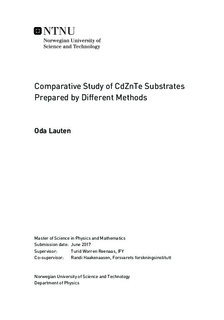Comparative Study of CdZnTe Substrates Prepared by Different Methods
Master thesis
Permanent lenke
http://hdl.handle.net/11250/2453418Utgivelsesdato
2017Metadata
Vis full innførselSamlinger
- Institutt for fysikk [2695]
Sammendrag
In this study, three different CdZnTe (CZT) substrates were characterised for surface impurity contamination, particles, and defects. The substrates were examined both as-received and after surface pre-growth preparation. As the final step, a layer of HgCdTe (MCT) film was grown on each substrate and examined. It is of great interest to obtain a better understanding of how impurities, defects, and particles on the CZT substrate surface affect the quality of the grown MCT film.
Two of the substrates were (111)B-oriented and used for liquid phase epitaxy (LPE) growth of MCT: substrate A from vendor A, generally recognised as fabricating the best CZT substrates, and substrate B from vendor B, which was compared to vendor A. One additional substrate from vendor B, substrate B2, was studied as well. The third substrate was (211)B-oriented and used for molecular beam epitaxy (MBE) growth of MCT, substrate C from vendor A. The characterisation consisted of a study by optical microscopy, scanning electron microscopy (SEM), energy-dispersive X-ray spectroscopy (EDS), atomic force microscopy (AFM), near-IR transmission microscopy, and Fourier transform infrared spectroscopy (FTIR).
The as-received substrate A had the best surface polish and crystal quality and had almost no particles on the surface. Surprisingly, the preparation etch procedure introduced more particles on the surface. The as-received substrate B had scratches, particles, and voids on the surface, and it had a larger surface roughness than the as-received substrate A by a factor of 10. The roughness decreased after the polishing procedure to about the same value as substrate A. The number of particles also decreased, but it was not as low as on substrate A. While the as-received substrate A had a density of polishing grit less than 2e4 cm-2, the as-received substrate C had an average density of 4e7 cm-2. The polishing grit density on substrate C was reduced by a factor of 10 after etch.
The surface of the MCT epilayers that were grown by LPE on substrate A and substrate B2 showed wavy structures on the surface with doughnut-shaped defects and large circular defects with a density of 1e4 cm-2 and 2 cm-2 respectively. The doughnut-shaped defects seemed to correlate with the polishing grit on substrate B2, but showed no correlation with the polishing grit on substrate A. The MCT epilayer that was grown by MBE on substrate C had a microvoid density of 1e5 cm-2, which correlated with polishing grit observed before growth.
